It’s that time of year again, when the cold starts to break and warmer weather gradually begins to grace us with its presence.As the seasons change, we often seek out and welcome food and drink that reflects our surroundings.When things start to heat up, our desire for beverages that quench our thirst and cool us off grows exponentially with the increase in temperature.In a world filled with slushies and punches, there is one classic cocktail that has been helping us usher in Spring and Summer for centuries: Sangria
HOW IS SHERRY AGED?
From the very moment the wine becomes sobretabla (the origin of finos, manzanillas, amontillados and palo cortados), or goes directly to a criadera (oloroso, pedro ximénez and moscatel), an incredible process takes place inside of those casks resting within the walls of the impressive, classic cellars. After many years of meticulous hard work, the wines will be patiently transformed into exuberant expressions of pure terroir via, again, their great complexity and singularity.
The solera and criaderas system is so attached to the region, that its popular image (showing long rows of centenary casks carefully stocked) is generally the first picture that comes to our mind when thinking about a sherry bodega, even though, we may overlook the importance of the role of the aging system itself!
Along with the particularities of the aging systems and the blending processes regularly performed, which ultimately have a tremendous impact on the wines, there are other key factors responsible for the profile of these unique liquid treasures. Among others, the origin and age of the actual casks, where they are located within the region and how they are arranged, the design of the rooms where the casks are found, the always imperfect human intervention, or (obviously) the length of time that the wines spend aging, will all contribute to the final character of sherry in some measure.
On the other hand, not all sherry wine is aged through the solera and criaderas system these days. Every year, there is a tiny fraction of wine that takes a completely different route, aged separately, without the customary blending with wines from other harvests: Vintage Sherry. Today, these rare wines, currently much less common than the solera-system wines, add priceless nuances to the already expansive range found across the appellation. Amontillados, finos (very rare), olorosos and palo cortados all channeling the individual characteristics of their particular year of production. Contrasting both solera and vintage, say, olorosos with the same age is a fascinating exercise.
Conversely, vinos de añada (vintage sherry), or ‘static aging’ wines were the norm before the invention of the solera system. Let’s see what happened.
HISTORY AND ORIGINS OF THE SOLERA Y CRIADERAS SYSTEM
A lot of literature has been written about the solera system, trying to explain how this half-magical, half-scientific aging process works. Dozens of diagrams and images can be found on the web. Many of these are simple illustrations of how the solera system is generally handled in a bodega, so in this section, we will try to provide you with a little bit of background on its ancient origins.
Like many other techniques or historic events, this system emerged as a solution to a problem caused by a dispute between different factions. The origins of the solera system and this remarkable way of aging wine date back to the 18th century (around 1760-1770), a very interesting period for Jerez and an important landmark in the long and extensive timeline of the region.
Sequentially, in 1733 in Jerez, 1737 in Sanlúcar, and 1745 in El Puerto groups of the already dominant landlords and growers came together to eventually establish the Harvester Guild (Gremio de Cosecheros). Over time, this new extraordinary force imposed very restrictive policies on winemakers, wineries, and almacenistas, such as fixing grape prices, or setting the prohibition of a speculative stock of wine, compromising the wineries ability to at liberty distinctively age wines. Consequently, sherry started to become an unsophisticated, unaged wine, struggling to compete with other international wine-producing regions. Progressively, this restrictive control from the guild made it virtually impossible for “extractors” (winery owners) to give their wines the added value they needed.
It is around 1760 when winemakers and extractors, in a growing disaffection with the guild’s ruling positions, begin to experiment at the wineries, developing, firstly in Sanlúcar, a dynamic blending system that could give complexity and depth to the wines while maintaining the supply of base wines produced each year. The solera system spark-ignited a full movement against the guild, nevertheless it would take almost a century for it to fully develop as we know it today and to set up the whole region for its widespread use. This is also the time when the biologically aged “Flor” wines started to emerge, naturally nourished by this recently implemented aging method. Not surprisingly, it was also during the second half of the 18th century that the first grand Sherry Houses were born.
The guild finally disappeared in 1834, although many years before it had already begun to lose its influence. It was soon after 1778 when 31 bodega owners came together to face the guild’s regulations, once and for all, gradually diminishing its power over the region. This lobby of bodegueros started a legal dispute against the growers and vineyard owners, acting as an example for other wineries and merchants who readily followed suit.
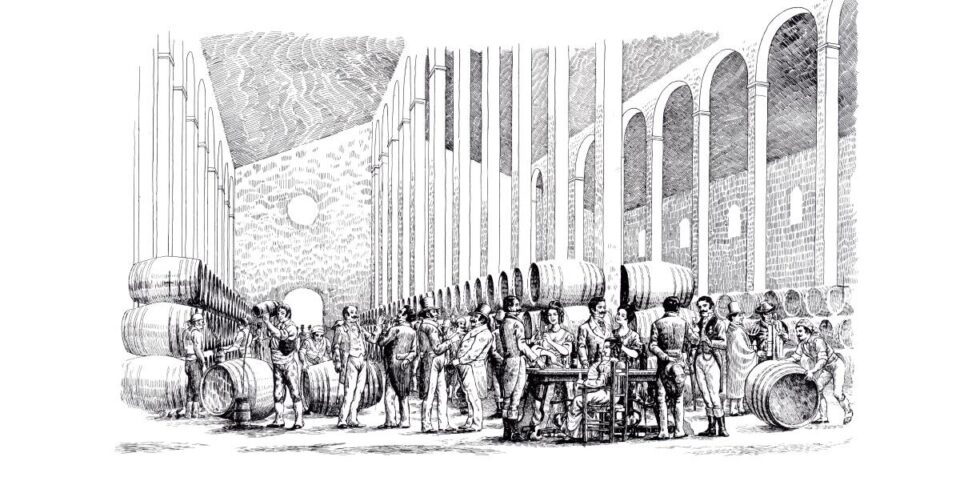
Although hard to summarize the dawn of the current sherry wines in just one historic milestone, we can say that the solera system helped the region make up the potential time they had lost early on, launching the wines of Jerez into a very prosperous 19th century.
HOW DOES THE SOLERA AND CRIADERAS SYSTEM WORK?
We mentioned above that the solera system is the iconic, traditional, and dynamic blending system carried out in Jerez (and to a lesser degree by a handful of other regions) to age their wines. But how does the solera system really work and what does it comprise?
In a more technical language, el sistema de solera y criaderas is “a dynamic system in which wines with different levels of aging are methodically blended maintaining a high level of quality, to ensure a specific personality, and achieve a maximum degree of homogeneity, despite any organoleptic variations of wines from different vintages.”
As we know, the solera group of barrels supplies the wine that is ultimately destined for consumption. The winemakers or cellar masters establish the frequency and quantity of wine to be extracted from the solera for bottling: the “saca”. Before a saca is extracted from the solera there are several steps to consider. No winemaker or “capataz” (foreman) decides to extract wine blindly. To avoid surprises, some critical tasks are performed before, during and after the sacas, such as “venenciados”.
Venenciado is always one of the winemaker’s paramount duties. This task lies in tasting every single cask of wine that will potentially be used for the following batch of wine to be bottled. The winemaker or capataz, together with the most experienced members of the team takes tiny samples to check the status, quality and personality of every wine contained in every bota that belongs to the same soleraje. It generally takes place early in the mornings (7.00 am), when the sense of smell is at its best. The word of venenciado comes from the tool used for taking the samples straight from the cask: la venencia. A long, flexible stem made of plastic or fiber is attached to a stainless-steel narrow cup, designed to obtain a sample of wine out of the barrel plunging the flor without disturbing it. Venenciados can take from half an hour to an hour, depending on the number of casks to complete the checking process. It is important to note that the wine is never tasted. With just the aroma, winemakers and capataces must know if the wine shows the desired profile that suits the given style. Yet, another factor must be taken into consideration, time. Casks must be checked, and wine must be evaluated rather fast; first, because of productivity reasons, and secondly, to align the senses and the nose to certain metrics in the wines within the same soleraje, thus allowing the winemaker to deftly identify the wines that stand out of the average.
After checking all the casks, the samples taken are mixed in a metallic jug (1@ capacity = 16.6 liters) and the future blend is evaluated by the winemaker. Once the winemaker approves the venenciado, the casks previously tasted are marked, and the wine will be extracted from those shortly after. The samples originally blended will be used as the point of reference for the actual batches and those following.
Venenciados are mostly carried out for finos and manzanillas since the flor creates a slew of differences among wines of the same soleraje. To ensure that the personality of the bottled fino or manzanilla is consistent, venenciados are not only performed before bottling, but also before doing the saca of the first and second criaderas. With no doubt, an enormous amount of work and responsibility.
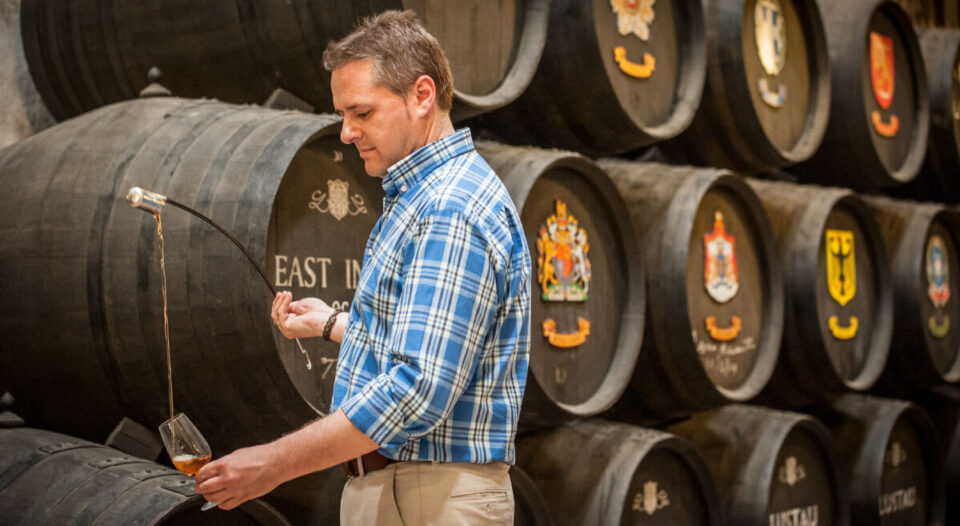
The solera system used for aging sherry also requires other supplementary tasks during the whole cyclical nature of the process. The “Aspillado”, for instance, concerns the reckoning of the inventory before and after a saca, or when homogenizations are done every single time an escala is touched. Doesn’t matter if we are talking about solera, first or second criadera, every escala needs to be under control to guarantee the wine is in perfect condition.
Aspillado is a secondary but crucial task left to “arrumbadores” (workers). It involves dropping a wooden stick through the cask hole to measure the amount of wine inside of it. The tool, named “aspilla”, has been conveniently marked to show the exact number of arrobas (1@ = 16.6 liters) contained. Simple and rather rudimentary but effective and reliable.
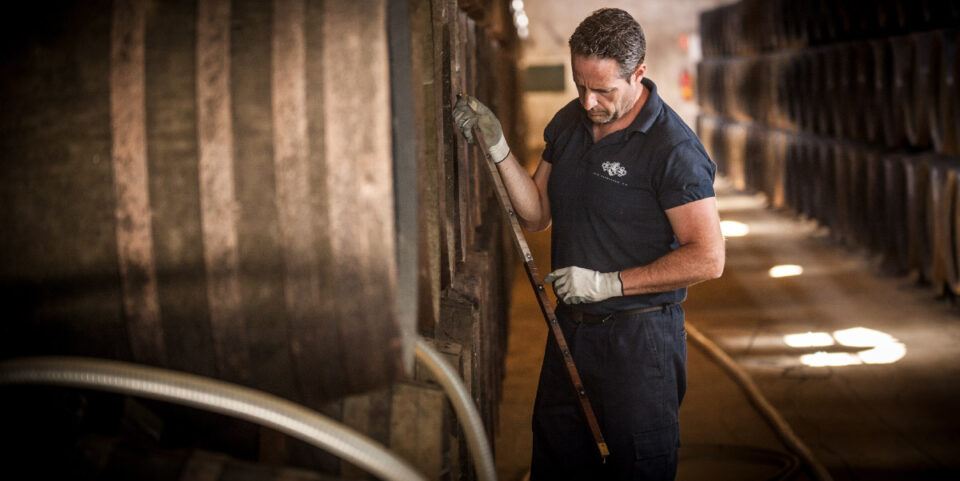
After the aspillado, it is time to inventory the amount of wine, writing down on the books the number of arrobas contained in the casks.
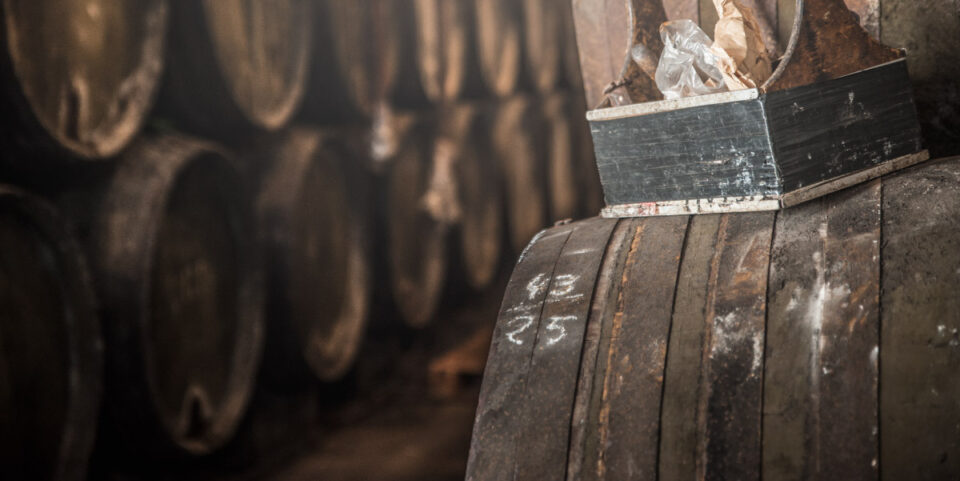
Finally, the transfer of wine from one stage to the next is termed the rocío. The rocío will complete the “running of the scales”. The extracted wines are then homogenized to make sure they turn out as a consistent, solid product, typically combined in a tank prior to transfer to the casks in the next row, again, with the same aim; consistency, personality, and identity.
Specifically, in biologically aged wines, the replenishing of the botas must be carefully performed to avoid disrupting the flor film on the wine’s surface (this is a significantly higher-impact operation than both the venenciado and the aspillado). This dynamic process generates uniformity in the character of the wine transferred to the next stage in the solera system. New wines are only gradually introduced to the system, and the influence of the new wine will disappear as it takes on the characteristics of the older sherry quite rapidly. By blending multiple vintages, the possible variability of each year will be lowered and after a certain number of years, the bottled wine will maintain a constant average age. In addition, the rocío operation, by blending older wines with younger wines, supplements the transfer of nutrients from the old to the young wine. The process also provides aeration, which is highly beneficial for the wine and the flor, as this favors the formation and maintenance of the yeast film.
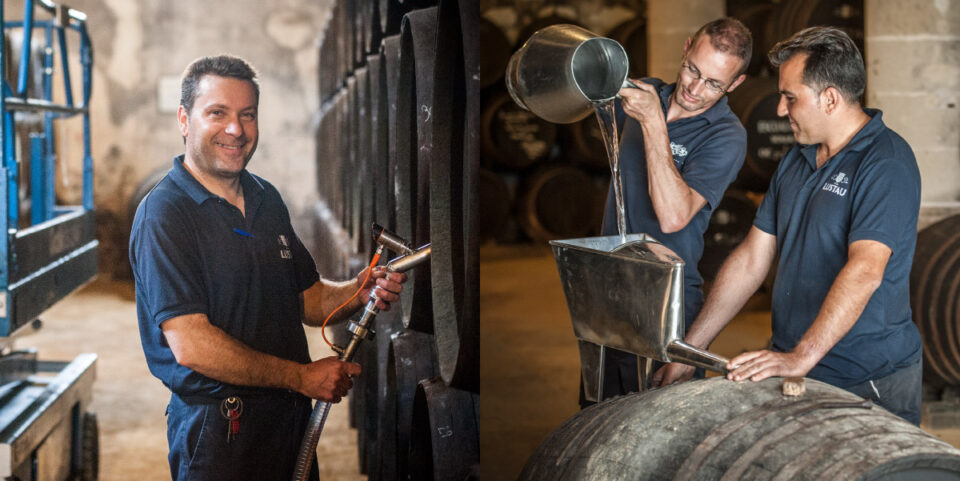
Predominantly, the highest criadera is topped up with young wine, but premium soleras that hold very old wines will be washed down with soleras of similar style, i.e. already mature wine brought to a certain state of aging outside of the solera.
Why is the solera system used for aging sherry?
Once more, thanks to the constant blending of different vintage wines, the wineries can guarantee a certain level of quality (very high in the region) and consistency, despite the potential fluctuation of the characteristics of the crop vintage after vintage. The system and the team at Lustau have managed to set a solid personality for the wines that can be kept, if it is their desire, endlessly. That is why, to name a few, East India Solera, Amontillado Los Arcos, or Fino Jarana are easy to identify.
Since 31 wine families refused to accept a restrictive regulation, the region has adopted the solera system as its iconic aging system.
Advantages and Disadvantages of using the Solera System
This system is fun and interesting because of its hues and nuances; it is greatly based on mathematics, which might initially come across as absolute perfection and at the end somewhat unpredictable too. That is the importance of the winemaker and the experienced team running the daily operation of the bodega.
The solera system, thanks to its complexity, has lots of advantages but also a few disadvantages. Below we outlined some of them for your review:
Advantages of the solera and criaderas system:
- It allows the winery to homogenize its products to ensure the same quality and personality across all its wines year after year.
- It allows extending the life of a wine (if it still belongs to the system) almost indefinitely. The constant addition of ‘fresher’ wine will make the solerajes last for centuries, if intended by the bodega.
- Flor and solera systems are closely related. Not only historically, but also when putting the theory into practice. Again, the consecutive addition of younger wines to the criaderas works as a nutrient supplier for the hungry yeast. The veil of yeast needs nutrients to survive. The solera system makes this possible, creating legendary finos and manzanillas (and amontillados) in the region.
- Although labor-intensive, the system is also designed to allow producers to keep an accurate count of the wine stocks. Everything is under control and properly located.
- Running the scales provides micro-oxygenation, opening the wines and contributing small yet valuable oxygen interaction for the proper aging of all the styles.
Disadvantage of the solera and criaderas system:
- It is a difficult system to work with given the puzzling processes involved and the extraordinary tasks required to master it.
- It demands total dedication and conscientiousness. The wines and the casks need to be checked periodically before, during and after every saca or rocío.
- The solera and criaderas system results in wines of overall average age. In some instances, and in very old soleras, it may be difficult to assess how old the wines truly are. The average age of the wines of a solera depends on the rotation of the total volume of wine contained in the system; the number of levels of which it is composed, the percentage of wine extracted in each saca, and the frequency with which these sacas are made.

We believe the advantages easily surpass the disadvantages, and if it didn’t require such difficulty, the wines surely wouldn’t be the same. We have sherry, in fact, thanks to the solera and criaderas system.







